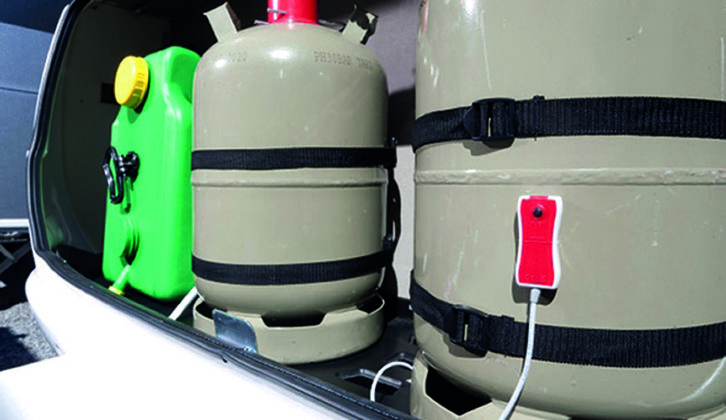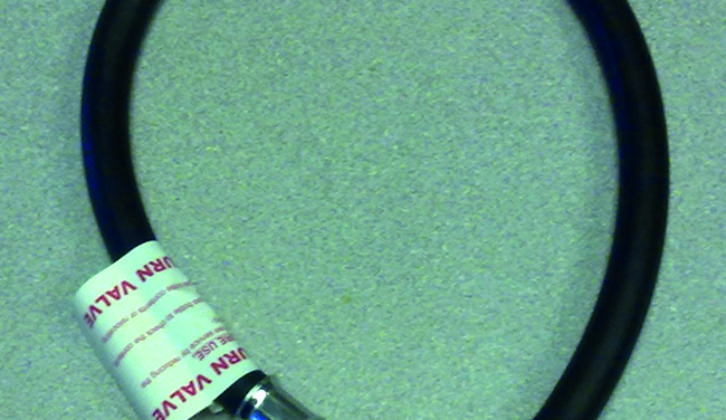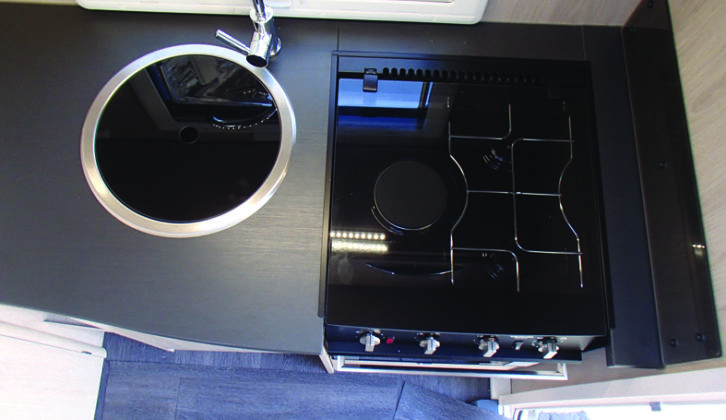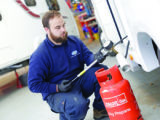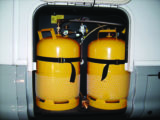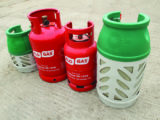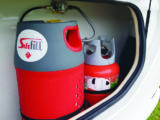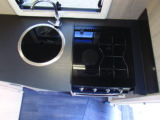Liquefied petroleum gas, commonly known as LPG, is a wonderful fuel. It’s versatile, easy to store and transport, and relatively clean. A single cylinder holds a vast amount of energy. In short, it’s the perfect fuel for touring, especially when you’re off-grid.
Not only is LPG ideal for cooking and heating, it will also chill your ‘van fridge. In fact, it’s the most efficient way to heat your ‘van and provide hot water – and keep your Lambrusco cool.
Burning any hydrocarbon fuel has a detrimental effect on the environment, of course, but LPG is one of the cleanest options. It’s non-toxic and low-carbon, burns cleanly and emits almost no black carbon or particulates, and every kg of LPG contains more energy than other options, so it’s also very efficient.
To keep LPG in its liquid state, it is pressurised and stored in cylinders, which are strong, safe and portable, and are easily obtainable in a wide range of sizes, to suit all motorhomes, budgets – and barbecues.
Gas cylinders must be stored in a compartment that is sealed off from the living quarters in your motorhome. This dedicated gas locker typically has enough room for two bottles.

With average use, two cylinders should be more than enough for a fortnight’s touring, and if you are in warmer climes (with judicious summer consumption), they could last an entire season.
Off-gridders, who rely on gas to power all of their facilities, will use considerably more, though, especially for winter touring.
Gas bottles should always be securely strapped into the locker, and the regulator pigtail fitted and tightened with a 30mm spanner.
It should be noted here that gas fittings have a reversed thread, so you undo the connections by turning the nut clockwise, which might seem a bit counterintuitive until you get used to it.
Ensure that the gas bottle is turned off at the top tap before removing it. When the pigtail pipe is separated from the bottle, you will smell a small amount of gas, but as long as the bottle is turned off, this is normal.
Finally, screw the plastic stopper into the bottle’s brass thread to protect it and prevent any small amount of leakage.
When retightening the pigtail nut on the gas cylinder, ensure that it is hand-tight; but do not over tighten it, because this might damage the threads and make removal more difficult.
Propane or butane?
Leisure vehicle gas supplies can be purchased in two different forms: butane and propane.
Butane has a marginally higher calorific value than propane, so it contains more energy per kg and less will be required to create the same amount of heat.
Propane creates 96 megajoules of energy per cubic metre, while the equivalent amount of butane produces 126 megajoules. This might make butane seem like the clearly obvious choice for motorcaravanners, but there is a much more important factor to consider – the temperature at which these fuels vaporise.
Butane will turn from liquid to burnable gas at temperatures down to minus 2ºC, whereas propane goes to minus 42ºC.
So while a cold winter night of minus 2ºC or lower will prevent your butane-fuelled system from working, the propane-powered motorhome owner can happily head off to the Arctic Circle, safe in the knowledge their heating will work! Gas type is definitely something for four-season tourers to consider. But how do these fuels compare costwise? This is more difficult to answer, because the amount you buy, and where you buy it, all affect the result.
However, in general, butane costs more (typically, less than 10% more). But remember, in theory, it should last 12% longer, making this a slightly cheaper heating choice. And then, just when you thought you knew which gas to buy, along comes another option, throwing a 30mm spanner into the works.
Refillable bottles
Several companies now offer refillable bottles, which you can fill yourself at Autogas pumps on fuel station forecourts.
On the Continent, Autogas is usually a mix of propane and butane, depending on the area’s winter temperatures. However, in the UK, it’s always propane.
Currently, a typical price for Autogas is 64.2p per litre, which compares favourably with Calor’s bottled gas (in rented cylinders) at around £2 per litre or more.
This saving makes it worthwhile for year-round motorcaravanners to consider a self-fill system, even though the set-up costs are significant.
Now, it’s time to take a look at the various gas supplier options that are available to you.
GAS SUPPLIERS
Calor

Calor operates a system where it ‘rents’ the gas bottle to motorcaravanners; when empty, this is swapped for a full one.
This set-up offers many benefits – it’s the most widely used across the UK, so is readily available almost everywhere, even in smaller towns. You’ll find many service stations keep bottles in stock, and UK campsites will often sell Calor gas.
Back in 2007, the company added to its range by bringing out a new, lightweight Calor Lite canister. This made fitting the gas bottles much easier, especially for those with limited mobility. It also helped to free up payload.
Unfortunately, a major product recall in 2014 – the result of potential safety problems – means that these days, access to Calor Lite bottles is now increasingly limited.
Buyers will also be paying a premium for Calor Lite bottles. Typically this is 10-15%, or around £3 on a 6kg canister.
Web calor.co.uk
Flogas

Flogas is another of the major suppliers in the UK bottle-gas market, offering both steel and lightweight composite cylinders.
Flogas works with cylinder maker Hexagon Ragasco to supply strong, light cylinders made from composite plastics.
These composite canisters won’t rust, and they are translucent (so you can easily check your gas level) and very strong. Flogas says its composite plastic cylinders are safer and stronger than their steel equivalents.
They also function in a wide range of weather conditions, from minus 40ºC to plus 65ºC, so a weekend in Morecambe shouldn’t trouble them!
The lightweight Gaslight cylinder has a 27mm clip-on connector. Adaptors (clip-on to threaded) are available online for about £8. A new clip-on pigtail costs from £25.
Flogas typically charges £2 to £2.40 per litre, so is comparable with Calor. Its distribution can’t match Calor’s, but most towns have a supplier.
Web flogas.co.uk
Safefill

Safefill is a relatively new operator in supplying bottled gas. Back in 2011, it launched a range of refillable, lightweight, composite gas bottles (similar to the Flogas ones).
These bottles are direct-fill, meaning that you can simply take them along to any Autogas supplier, typically a service station, and refill the bottle yourself.
Morrisons supermarket forecourts supply Autogas and have approved Safefill cylinders for use at their premises (you’ll find that some service stations don’t understand the system and might prevent you from refilling on their forecourts). Visit the website at www.mylpg.eu for a useful map of Autogas suppliers.
Safefill bottles come in 5kg, 7.5kg and 10kg sizes. They are lightweight and actually look quite cool (for a gas bottle!).
You purchase the gas bottles to start with (£158, £159 and £165, respectively – prices from LPGshop.co.uk), then refill them yourself, with the gas costing 64p per litre.
In fact, if you can track down a domestic LPG supplier, you might be charged a reduced VAT rate of 5%, meaning that each refill will work out significantly cheaper still.
Another important benefit of the LPG self-fill set-up is that you can keep your cylinder topped up, rather than having to set off on a trip with, say, just a quarter of the bottle remaining, and knowing full well that you’re going to have to find a supplier while you’re away.
At the time of writing, owing to the pandemic, demand is outstripping supply of Safefill bottles, so you might consider ordering early.
Safefill’s cylinders are also compatible with ‘standard’ gas connections, the same as Calor. Each cylinder is ISO rated and features several safety measures, such as overfill protection (all cylinders should only be filled to 80%, to allow for expansion), a safety valve to stop accidental gas release, and a pressure-release valve.
The bottles are self-installed, and must undergo a gas safety check every 10 years; although they should, of course, always be inspected as part of your motorhome’s annual service.
Web safefill.co.uk
Gaslow

Gaslow is also a self-filling system, but it takes a slightly different approach. The system is fitted permanently in your motorhome, with steel cylinders installed in the gas locker. It is modular, so you will be able to ‘specify’ it to suit both your needs and your budget.
Usefully, Gaslow has an integral gas-level gauge and, best of all, a filling valve that is permanently mounted on the side of your motorhome or inside the gas locker, with its own fuel-filler cap. The Autogas pump connects to this valve for easy refilling, with no need to haul out the cylinders.
Gaslow cylinders can be refilled at Autogas suppliers, so you will be paying around 64p per litre; but you do need to bear in mind the there will be significant costs for buying and fitting the bottles, pipework, gauge, adaptors, regulators and filler valve.
A single-cylinder system costs £361.50, which includes an R67 11kg cylinder. You can expect to pay around £100 for fitting by a suitably qualified technician. This job’s best left to the pros!
Web gaslowdirect.com
So, which is best?
You might as well ask, how long is a piece of string? This is one of those subjective questions that depends on individual preference. Each type of fuel supply has its pros and cons.
Motorcaravanners who will use relatively little gas might light the convenience of Calor or Flogas, and be prepared to pay a premium for that.
However, if price is the main factor and you’re a medium-to-heavy gas user, you can’t deny the huge savings you get from self-filling systems. So, for example, if you use 52kg of gas a year:
- Four Calor 13kg bottles will cost £142 (priced at calor.co.uk)
- Four Flogas 13kg cylinders will cost £152 (priced at flogas.co.uk)
- 102 litres of Autogas for Safefill or Gaslow, at 64p per litre, will cost £65.28 (1kg = 1.96 litres of LPG)
As outlined above, the upfront costs vary quite substantially for these options – only you can decide if the long-term savings will pay off.
How much gas is left?
You can keep an eye on the remaining gas supply contained in steel bottles with any number of level-check devices.
For example, the Gaslevel GL 3001 costs around £35, attaches magnetically to the side of a steel cylinder, and displays green or red lights to show the level of the gas inside the canister.
Starting at the top, you simply need to move the device down the side of the bottle until the red light turns green. That indicates the level of gas remaining inside.

Truma’s LevelControl (from £120) links to its iNet system via Bluetooth, so you can check the level from your phone. The company also supplies he handheld Truma Gas Level Check, with prices starting at around £62.
Gas safety
LPG is highly flammable, odourless (the smell is added to warn when there’s a leak) and heavier than air. This means that it will sink to the floor, which is why motorhomes have gas drop-out vents in the floor. These should never be sealed.
In a full vehicle service, the LPG hoses and regulator will be inspected, not just for damage, but also for their age. An LPG regulator has a 10-year lifespan and the hose, five years.
Auto shut-off
Pressure-sensing valves cut the flow of gas from the bottle if the system develops a leak. Costing about £60 online, they simply screw in, between the pigtail and the bottle.
The GasStop valve features a European-spec nut, which is smaller than standard British ones, although a suitably sized spanner is also supplied. In addition, the valve has a gauge, which displays how much gas is remaining.
Smoke and CO alarms

Alarms to warn you about the presence of smoke or carbon monoxide (CO) are essential safety devices for your motorhome.
If burnt exhaust fumes from your boiler, fridge or cooker leak into the vehicle’s interior, they can be highly dangerous. They contain CO, which can overcome an adult in a matter of minutes, quickly leading to suffocation. So these relatively cheap gadgets might just save your life.
TOP TIPS FOR GAS
- If your gas bottle in running low, try to time the changeover to take place during daylight hours, rather than having to endure a cold, rainy, midnight ’emergency’ bottle swap.
- Never store any of your motorhome gas cylinders in a sealed awning or pup tent.
- Ring around for the best gas prices. When recently buying a 13kg Calor gas bottle, we found local prices ranging from £42 to £57.
- 1kg of propane equals 1.96 litres, 1kg of butane equals 1.72 litres
- Don’t try to save money by using cheap adaptors bought online to attempt to refill rental cylinders yourself at an Autogas pump. This is both illegal and dangerous, because rental cylinders do not have the safety features built into refill bottles.
- Consider the weight of your cylinders. Two full 6kg propane cylinders typically weigh about 15kg each. Throw in a good-quality 100Ah leisure battery and you’ll have taken 50kg or more out of your allowable weight.
- All elements of your motorhome gas system should be serviced every year, both for safety and to ensure that they are functioning efficiently.
- Ensure that you keep your gas cylinders upright, and turn them off when they’re not in use.
- Turn off gas bottles for travel via the Channel Tunnel or on ferries. You can carry up to 50kg of gas in portable cylinders through the Tunnel.
- Calor gas is not available on the Continent. Make sure you take sufficient supplies with you, or buy a pigtail adaptor so you can use European-spec cylinders.
- All current UK motorhomes feature gas-pressure regulators which run at 30mbar. These function safely with non-UK cylinders, provided that the correct pigtail/adaptor is being used.
- Club sites typically don’t allow gas cylinders over 15kg to be stored outside the motorhome.
- If you carry two gas cylinders, consider fitting an auto-changeover valve, available from companies including Gasflow and Truma. These will switch the gas supply automatically between the bottles whenever one of them runs out.
- All of the gas-burners in a motorhome are fitted with flame-failure devices, ensuring that the gas flow is cut off if they stop burning.
- If your cooker or other appliance is burning with a yellow flame, it is not burning correctly and requires maintenance. If all is functioning as it should, it will burn with a blue flame.
- If you ever enter your motorhome and encounter a strong smell of gas, DO NOT turn on any of the electrical appliances or light. Move everyone away from the vehicle and leave the door, windows and gas-locker hatch open, to allow the gas to disperse. Contact a gas engineer immediately.
- Always use a qualified, registered gas engineer if you require work on your motorhome’s gas system.
Future Publishing Limited, the publisher of practicalmotorhome.com, provides the information in this article in good faith and makes no representation as to its completeness or accuracy. Individuals carrying out the instructions do so at their own risk and must exercise their independent judgement in determining the appropriateness of the advice to their circumstances. Individuals should take appropriate safety precautions and be aware of the risk of electrocution when dealing with electrical products. To the fullest extent permitted by law, neither Future nor its employees or agents shall have any liability in connection with the use of this information. You should check that any van warranty will not be affected before proceeding with DIY projects.
If you liked this… READ THESE:
Motorcaravanning for Beginners: everything you need to know
If you’ve enjoyed reading this article, why not get the latest news, reviews and features delivered direct to your door or inbox every month. Take advantage of our brilliant Practical Motorhome magazine SUBSCRIBERS’ OFFER and SIGN UP TO OUR NEWSLETTER for regular weekly updates on all things motorhome related.
LPG is flammable, odourless and heavier than air, which is why motorhomes are fitted with floor vents







